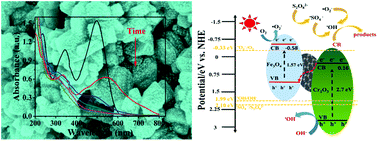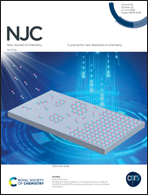The photocatalytic performance and mechanism of magnetically retrievable Z-scheme Cr2O3–Fe3O4/C hetero-nanostructure polyhedra
Abstract
In this study, Z-scheme Cr2O3–Fe3O4/C hetero-nanostructure polyhedra are prepared using the amine-functionalized metal–organic framework NH2-MIL-101(Fe) as the precursor through a simple hydrothermal method and impregnation–calcination route. Systematic characterization was conducted on the phase structure, morphology, optical/electrochemical properties and the photocatalytic performance exhibited by the magnetic Cr2O3–Fe3O4/C samples. As observed from the results, Congo red (CR) degradation rates of the magnetic polyhedron-like Cr2O3–Fe3O4/C hetero-nanostructures under visible light are found to be nearly 1.86 and 1.21 times higher than those achieved by Cr2O3 and Fe3O4/C samples, respectively. Complying with the results achieved by the active specie tests, superoxide radicals could be the major active species in the CR photocatalytic degradation due to graphite carbon with high conductivity. On this basis, a model Z-scheme photogenerated carrier transfer system was developed. In the present paper, an approach for developing and designing Z-scheme hetero-nanostructure photocatalysts for purifying wastewater is presented.



 Please wait while we load your content...
Please wait while we load your content...